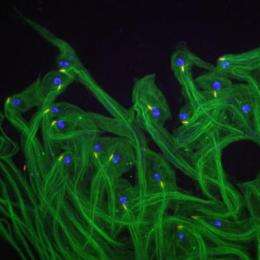This is a picture of Drosophila melanogaster (fruit fly) sperm, showing the growing flagella (in green). The structure at the base of flagella is shown in red, and blue marks the DNA of each sperm cell. Credit: Zita Carvalho-Santos, IGC
Sperm swim, lung cells sweep mucus away, and the cells in the female Fallopian tube move eggs from the ovary to the uterus. Underlying these phenomena are flagella – slender, hair-like structures extending from the surface of the cells, that bend, beat or wave rhythmically. In the latest issue of the journal Developmental Cell, scientists from the Instituto Gulbenkian de Ciência (IGC), in Portugal, have dissected how sperm cells of the fruit fly build their flagella. These findings pave the way to further understand the molecules and processes that may trigger a variety of human diseases and disorders, including infertility, respiratory problems and hydrocephaly, known to be associated with defects in flagellar movements.
Using electron microscopy – which allows scientists to see structures that are 3,500 times thinner than a strand of human hair – Monica Bettencourt-Dias and her team described, for the first time ever, the different steps involved in making a motile flagellum in sperm cells of the fruit fly (Drosophila melanogaster). The team was particularly interested in when and how a critical protein structure – called the central microtubule pair – is formed. Without the central microtubule pair complex, the flagellum is unable to move in a coordinated fashion.
This is an electron microscopy picture of a section through the flagellum of a Drosophila melanogaster sperm cell. The base of the flagellum is on the left, and the falgellum's skeleton extends from left to right. The black arrowhead points to the first chain of the central microtubule pair, without which the flagellum cannot move in a coordinated fashion. Credit: Zita Carvalho-Santos, IGC
Zita Carvalho-Santos, a post-doctoral researcher, explains what they found, "We looked at a particular fly gene, called Bld10, and found that flies in which this gene is inactive produce sperm with incomplete flagella because, it seems, the Bld10 protein is essential for the central microtubule pair to form. As a result, mutant sperm are immobile, and male flies are infertile. Humans have an analogous gene that produces a similar protein, which has been linked to male infertility."
The researchers built on work carried out in the 1970s that described the process of spermatogenesis in the fruit fly, to produce the most detailed description of flagellar biogenesis in an animal cell to date.
Monica Bettencourt-Dias adds, "We found that the process is much more dynamic than we had anticipated: first a single microtubule chain forms, and then the second. Our work has provided several long-awaited answers, but also raised other questions, that studying sperm formation in Drosophila may answer."
Journal information: Developmental Cell
Provided by Instituto Gulbenkian de Ciencia




















